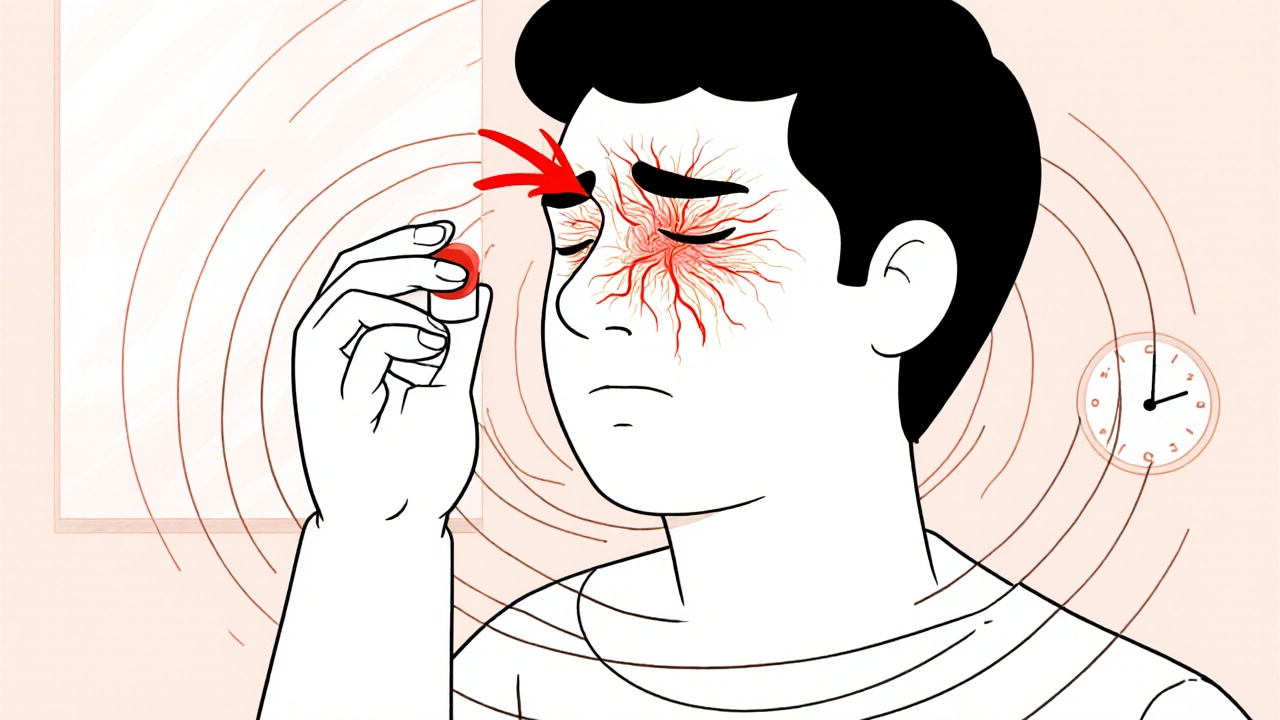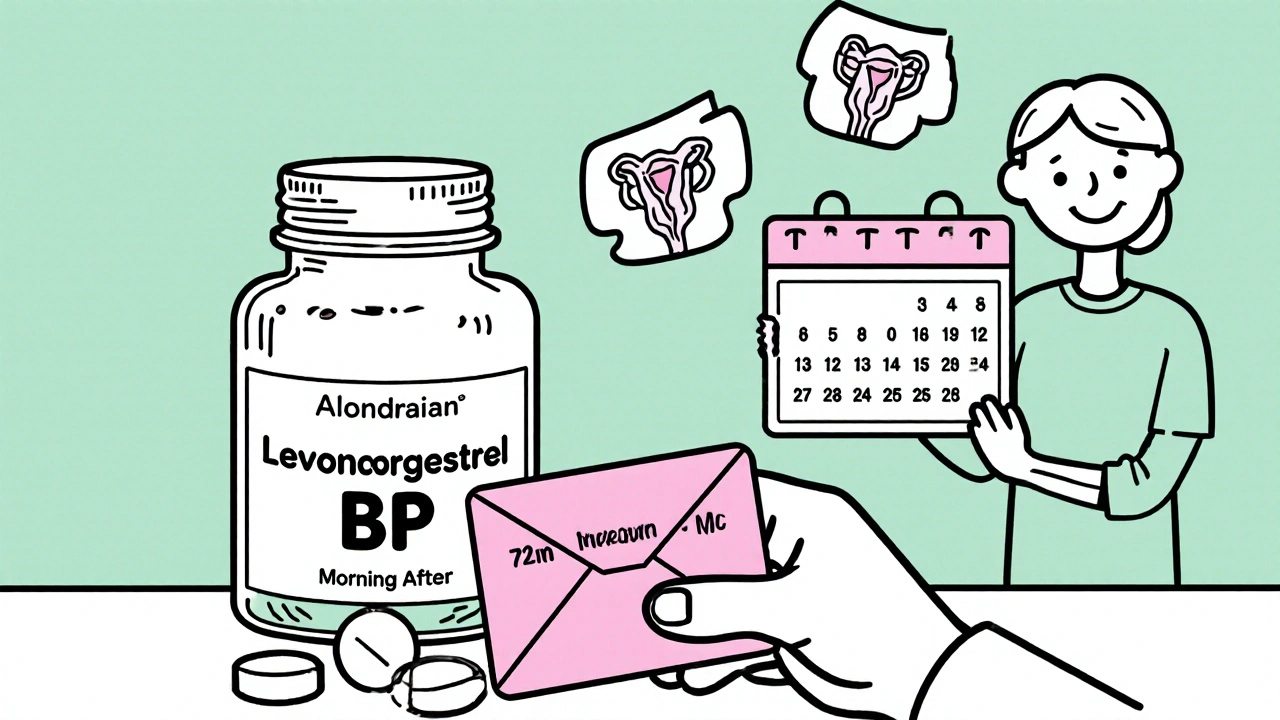If you’re staring at a bottle of desvenlafaxine (Pristiq) and hoping it’ll keep migraines away, here’s the uncomfortable truth up front: the research is thin. Venlafaxine (its parent drug) has modest evidence for prevention. Desvenlafaxine? Almost none. That doesn’t make it useless-especially if you already take it for anxiety or depression-but it’s not a go-to migraine preventive in 2025.
TL;DR
- Evidence: Direct data that desvenlafaxine prevents migraines is limited. Venlafaxine XR has small trials showing benefit; guidelines still don’t list desvenlafaxine as a standard option.
- When it may help: If you already need an SNRI for mood or anxiety, it can be reasonable to try for 8-12 weeks while tracking monthly migraine days.
- Not first-line: Topiramate, beta blockers (propranolol, metoprolol), CGRP blockers (mAbs/gepants), and onabotulinumtoxinA have stronger evidence.
- Safety: Watch blood pressure, sleep changes, nausea, sweating, sexual side effects, and drug interactions (triptans, MAOIs, linezolid).
- Bottom line: Use it when mood treatment is needed anyway or after other options fail-not as the starting point.
What we actually know (and don’t) about desvenlafaxine for migraine
If you want the straight clinical story: desvenlafaxine is the active metabolite of venlafaxine. It’s an SNRI-so it raises serotonin and norepinephrine-and it’s approved for major depressive disorder. It’s not approved for migraine prevention. Any use here is off-label.
Evidence snapshot: venlafaxine extended-release (XR) has a few small randomized trials from the early 2000s showing fewer headaches vs placebo in episodic migraine. The American Academy of Neurology/American Headache Society guideline historically rated venlafaxine as “probably effective,” a notch below top-tier options like topiramate or propranolol. The American Headache Society’s more recent clinical guidance (2024) centers on CGRP-pathway drugs, onabotulinumtoxinA for chronic migraine, and time-tested orals. Desvenlafaxine isn’t singled out as effective in these summaries because we don’t have solid trials for it.
Mechanism check: SNRIs may help by dampening central pain signaling and stabilizing brainstem circuits that misfire during migraine. They can also improve sleep and mood, which often amplifies migraine frequency. That’s the plausible “why.” But without randomized trials, the “how much” remains guesswork.
What to expect if you try it: for any preventive, the typical target is at least a 50% drop in monthly migraine days after 8-12 weeks at a stable dose. With SNRIs, the effect (if it happens) may be modest-think fewer attacks, sometimes less intense attacks, and better tolerance of triggers. If you’re on desvenlafaxine for mood already and see a meaningful drop in attacks, great. If not, you don’t keep it for migraine alone.
Where it fits in the real world:
- You have depression/anxiety and migraines, and your prescriber prefers an SNRI-you could see a two-for-one benefit. Venlafaxine XR has more migraine data. Desvenlafaxine is a simpler PK option (no reliance on CYP2D6), but the migraine evidence isn’t there yet.
- You’ve failed (or can’t tolerate) standard preventives and want something that may help mood too. A reasonable trial is fine, with clear stop rules if no benefit.
- If migraine is your only problem and you want the most reliable relief, go with guideline-backed options first.
What the numbers say (big picture): placebo-subtracted monthly migraine day (MMD) reductions in modern trials look like this-CGRP monoclonals and gepants: roughly 1-2 fewer days per month over placebo; topiramate: about 1 day; propranolol: under a day; onabotulinumtoxinA for chronic migraine: about 2 fewer headache days vs placebo. Venlafaxine XR’s trials suggest a possible benefit, but the studies were smaller, and the estimated effect is less precise. Desvenlafaxine doesn’t have comparable RCTs.
Sources worth knowing: American Headache Society clinical updates (2024), Cochrane reviews on oral preventives, the PREEMPT trials (onabotulinumtoxinA), and atogepant/rimegepant trials for oral CGRP blockers. These shape how doctors choose preventives in 2025.

How to try desvenlafaxine safely and see if it’s working
If you and your clinician decide to try it, treat it like any other migraine preventive-structured, measured, and time-limited.
Before you start
- Confirm migraine type: episodic vs chronic, with or without aura. Prevention is most helpful if you have 4+ monthly migraine days, significant disability, or frequent rescue med use.
- Set a baseline: track monthly migraine days, headache hours, and acute med use for 2-4 weeks.
- Check blood pressure: SNRIs can raise it. If you have uncontrolled hypertension, fix that first.
- Review meds: triptans are usually OK with SNRIs, but watch for serotonin syndrome symptoms (rare). Avoid MAOIs and use caution with linezolid or methylene blue.
- Plan sleep: insomnia can trigger migraines. Start in a week when you can protect sleep.
Dosing and titration (typical, not medical advice)
- Start: 25-50 mg once daily. Most depression data uses 50 mg; many patients do fine there.
- Adjust: If tolerated but no migraine benefit by week 4-6, some clinicians increase to 75-100 mg. Above 100 mg, side effects tend to rise without clear added migraine benefit.
- Time to effect: Expect 2-4 weeks for mood; 8-12 weeks for migraine prevention. Don’t call it a failure before week 8 at a stable dose, unless side effects force a stop.
- Stopping: Taper over 2-4 weeks to avoid discontinuation symptoms (dizziness, “brain zaps,” irritability).
Tracking what matters
- Primary metric: monthly migraine days (MMDs). Aim for ≥50% reduction. A 30% reduction can still be meaningful if attacks are shorter or easier to treat.
- Secondary: acute med days, work/school days missed, HIT-6 or MIDAS scores, sleep quality.
- Side effects to watch: nausea, dry mouth, sweating, constipation, decreased libido, insomnia, elevated BP. These often improve in 1-3 weeks.
Safety and interactions
- Blood pressure: check at baseline and after dose changes. Report sustained increases.
- Serotonin syndrome: uncommon with triptans + SNRIs, but know the signs-agitation, tremor, sweating, fever, diarrhea. Seek care if severe.
- Bleeding risk: higher if you use SSRIs/SNRIs with NSAIDs, aspirin, or anticoagulants. Use gastroprotection if you’re a heavy NSAID user.
- Eyes: can raise risk of angle-closure in susceptible folks. Sudden eye pain or vision changes need urgent care.
- Electrolytes: rare hyponatremia, more in older adults, low body weight, or on diuretics. Check sodium if you feel weak or confused.
- Pregnancy/breastfeeding: data is limited. Discuss risks vs benefits. Neonatal adaptation symptoms can occur with late-pregnancy exposure.
When to pivot
- No meaningful change by week 12: taper and switch to a better-supported option.
- Partial response (e.g., 30% improvement) but side effects are tolerable: consider staying, or swap to a drug with stronger evidence for a bigger gain.
- Great mood benefit but little migraine effect: keep it for mood, and add a migraine-specific preventive (e.g., CGRP agent) if appropriate.
Rules of thumb
- Pick preventives that also treat your biggest comorbid problem (sleep, mood, weight, blood pressure).
- Give each option a fair shot (8-12 weeks) before you switch.
- Avoid medication overuse: use triptans/NSAIDs ≤10 days/month (triptans/combination) or ≤15 (simple analgesics).
- One change at a time: it’s the only way to know what helped.

Alternatives, comparisons, and your decision guide
Here’s where desvenlafaxine sits next to common preventive options. Estimates are rounded and based on guideline summaries and pivotal trials.
| Preventive | Evidence strength | Typical placebo-subtracted MMD reduction | Common trade-offs | Best fit when… |
|---|---|---|---|---|
| Topiramate | High (episodic) | ~1 day/month | Paresthesias, cognitive fog, weight loss, kidney stones | Weight loss desired; no history of stones/cognitive sensitivity |
| Propranolol/Metoprolol | High (episodic) | ~0.5-1 day/month | Fatigue, low BP/HR, depression risk, sexual side effects | Also need heart rate/BP control; anxiety with tachycardia |
| Candesartan | Moderate | ~1 day/month | Low BP, dizziness, high potassium | Hypertension, ACE/ARB tolerance |
| Amitriptyline | Moderate | ~1 day/month | Sleepiness, weight gain, dry mouth | Insomnia, underweight not a concern |
| Venlafaxine XR | Moderate (small RCTs) | Uncertain; likely modest | Nausea, sweating, BP rise; discontinuation effects | Mood/anxiety + migraine; patient tolerates SNRIs |
| Desvenlafaxine | Low (limited data) | Unknown | Similar to venlafaxine; simpler metabolism | Already on it for mood; trying off-label |
| CGRP mAbs (erenumab, fremanezumab, galcanezumab, eptinezumab) | High | ~1-2 days/month | Constipation (erenumab), injection reactions; cost | Want strong evidence and easy dosing (monthly/q3mo) |
| Gepants (atogepant, rimegepant) | High | ~1-2 days/month | Nausea, constipation; liver considerations; cost | Prefer oral, avoid injections; frequent attacks |
| OnabotulinumtoxinA (chronic migraine) | High (chronic) | ~2 headache days/month | Neck pain, cost, every 12 weeks injections | 15+ headache days/month, failed orals |
Key takeaways from the table:
- If you want the fastest path to fewer migraines, start with proven options unless you have a strong reason to pick an SNRI.
- Desvenlafaxine makes sense if you already need it for mood and your clinician wants to see if it also helps your head.
- If weight gain, sedation, or low blood pressure are dealbreakers, SNRIs can be a reasonable pivot-just keep expectations modest.
Quick decision guide
- You have depression/anxiety + migraines and aren’t on meds yet: consider venlafaxine XR first if choosing an SNRI with some migraine data. If you’re already on desvenlafaxine and doing well mentally, a trial is reasonable.
- You’ve tried topiramate and a beta blocker without success: look at CGRP mAbs or atogepant. They’re consistently effective and often well tolerated.
- You have chronic migraine (15+ headache days/month): onabotulinumtoxinA or a CGRP monoclonal are tried-and-true options.
- You want oral, not injections: atogepant (daily) or rimegepant (every other day) are good modern picks.
Practical checklist
- Confirm diagnosis and baseline MMDs.
- Pick one preventive that matches your comorbids (sleep, mood, BP, weight).
- Set a clear trial window (8-12 weeks) and the success bar (≥50% MMD reduction).
- Track side effects weekly; adjust or taper if they don’t settle by week 3.
- Keep acute meds under overuse thresholds.
- Schedule a follow-up to make the go/stop call.
Mini‑FAQ
- Can desvenlafaxine actually trigger migraines? It’s not a known trigger, but insomnia, BP changes, or dehydration from side effects can set off attacks. Fix those and attacks often settle.
- Is the triptan + SNRI combo dangerous? The FDA flagged the risk years ago, but later reviews suggest the absolute risk of serotonin syndrome is low. Still, know the signs and don’t stack other serotonergic meds without guidance.
- If I’m already on desvenlafaxine and still get 8+ MMDs, what next? Don’t pin everything on the SNRI. Add or switch to a well‑supported preventive like a CGRP blocker or topiramate, depending on your profile.
- Is venlafaxine better than desvenlafaxine for migraine? Venlafaxine XR has actual migraine trials; desvenlafaxine doesn’t. If migraine prevention is the main goal, venlafaxine XR has the edge.
- How long should I try desvenlafaxine for migraine? Give it 8-12 weeks at a stable dose while tracking MMDs. If you don’t see a clear win, taper and move on.
- Does it help tension‑type headache? Some clinicians use SNRIs when tension and migraine overlap, mainly for mood and central pain modulation, but trials are limited.
Next steps and troubleshooting (pick your scenario)
- You already take desvenlafaxine for mood, 6 MMDs/month, using triptans twice weekly: Start a formal 12‑week prevention trial. Keep your dose steady (50-100 mg), track MMDs, and cap triptan days at ≤10/month. If you hit a 50% drop by week 12, keep it. If not, add a CGRP agent or consider switching to venlafaxine XR or another preventive.
- You’re medication‑sensitive, worried about weight gain, and have borderline high BP: Desvenlafaxine can nudge BP up, so monitor closely. Candesartan or a CGRP agent may be a cleaner fit. If you do try desvenlafaxine, start at 25-50 mg and check BP weekly for the first month.
- Chronic migraine after topiramate and propranolol failures: Go straight to onabotulinumtoxinA or a CGRP monoclonal. Desvenlafaxine is unlikely to beat those here.
- Pregnancy planning: Prevention gets tricky. Non‑drug strategies first. Discuss risks and alternatives. CGRP agents aren’t well‑studied in pregnancy either. Loop in OB and neurology early.
- Severe insomnia on desvenlafaxine: Shift dosing to morning, tighten sleep hygiene, consider a short run of sleep support if appropriate. If insomnia persists and migraines worsen, taper off and switch.
One last SEO‑friendly note for clarity: if you’re searching for desvenlafaxine migraine because a friend swears it cured theirs, remember that individual responses vary a ton. Your smartest move is to match the drug to your full picture-headaches, mood, sleep, blood pressure, budget-and give each option a real trial with clear rules for success.
Credibility check: The framing above aligns with American Headache Society clinical guidance (2024), long‑running evidence summaries from the American Academy of Neurology, Cochrane reviews on oral migraine preventives, the PREEMPT program for onabotulinumtoxinA, and pivotal trials for atogepant and rimegepant. That’s the current state of play in 2025.









19 Comments